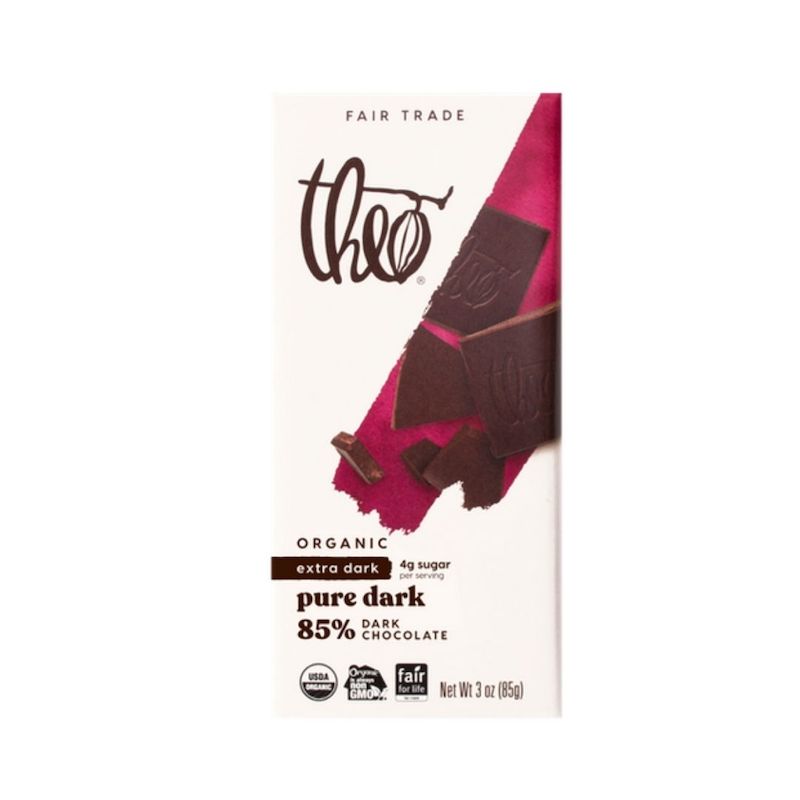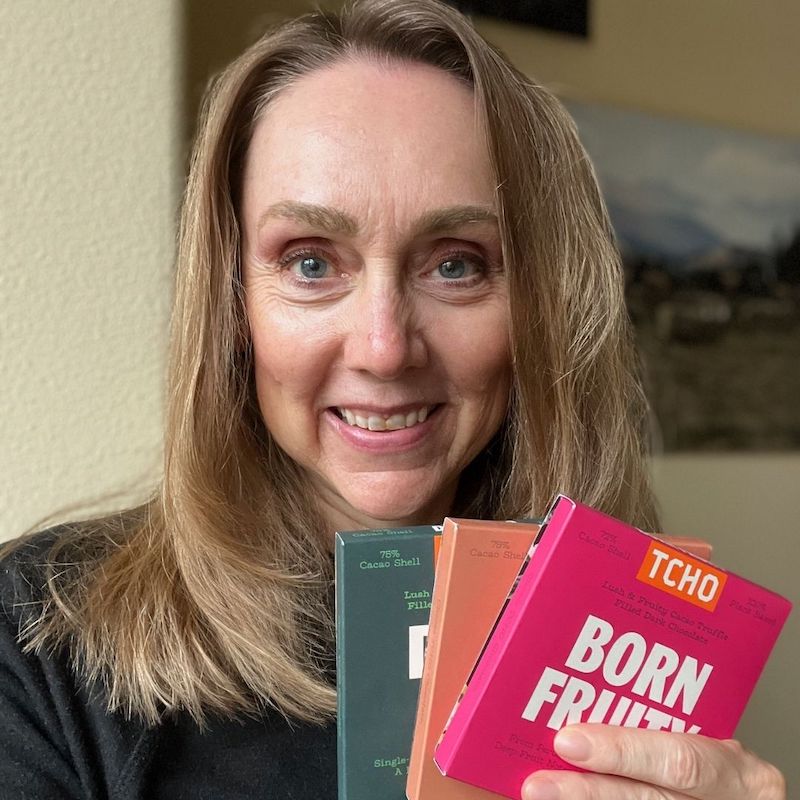When a box of chocolate arrived on my doorstep the other day, my husband just shook his head.
He just doesn’t get my craving for chocolate. (I remind him that I don’t understand his “thing” for his little red sports car, and that’s okay 😉 )
I love chocolate. I’m talking LOOVVVEEEE! No matter how much I pay attention to what I eat, I’ll never forgo the best things in life.
And for me, that includes chocolate.
When I was a little girl, I loved Halloween. Long after I was too old to trick or treat around the neighborhood, I would be the one handing out candy at the door. One for you. One for me. And only “the best” would do, which was KitKat’s, Snickers, and Almond Joy.
My tastes changed as I aged. As I made changes in my life to make healthier choices, I quickly learned that candy wasn’t all that healthy. I moved to dark chocolate, convincing myself that it was “healthy.” Almond Joy is made with dark chocolate, so it must be healthier. Right?
Um, no.
Let’s talk about chocolate
Today, we think of chocolate as a sweet treat. That’s not how chocolate originated.
Throughout history, chocolate was a revered but bitter beverage often used in ceremonies. While the true origination can only be guessed at, trace chocolate was discovered around 1500 BC in ancient Olmecs of Southern Mexico.
The love of chocolate was passed down to ancient Mayans, who also mentioned chocolate drinks in a variety of transactions. It wasn’t reserved for the wealthy, but was readily available to all throughout the culture.
The Aztecs also enjoyed using chocolate to create beverages both hot and cold. They used the cacao bean as currency, and were considered more valuable than gold. An Aztec ruler supposedly drank gallons for energy and as an aphrodisiac. Because of its high energy qualities, he reserved it for military use as well.
Chocolate had medicinal uses too
Maybe chocolate was given a lot of value because ancient civilizations found chocolate to have a variety of health benefits too.
- The Aztecs used a chocolate drink to treat infections.
- The grounds of cacao beans were mixed with other plant roots to help children suffering from diarrhea.
- Another recipe was shown to use cacao as a cough treatment.
- Still another showed cacao used for a variety of ailments, including gout, dysentery, hemorrhoids, fatigue, and even dental problems.
However, in all of these formats, the cacao bean was used as close to the original as possible. It may have been ground up or brewed. But it was a natural product that didn’t add a variety of other substances – ie sugar – to increase its use.
It wasn’t until the mid-1800s that modern chocolatiers discovered how to turn the mighty little cacao bean into the chocolate we know and love today.
Today, Nestle is one of the biggest mass producers of chocolate. They make it sweeter and creamier, making it more appealing to a broader audience.
If you purchase chocolate from the grocery shelves today, it has added sugar, milk, and preservatives. What it doesn’t have is a lot of chocolate at all. Yes, even the “chocolate” flavor is often imitated using different additives.
What about modern-day health benefits?
It’s often funny reading what ancient cultures used different products for. After decades of scientific research, we understand a lot more about what’s healthy … and what isn’t.
That’s what makes it challenging to think that something on our “love to eat” list might actually be good for us.
I’ve read a lot about chocolate over the years. A lot of studies have been done on the benefits of chocolate. Dark chocolate is the clear winner here because of the benefits it brings to the table.
You can refer to resources like this – or this. Or do your own research – dark chocolate is well researched. And it:
- Is nutritious – a 100-gram dark chocolate bar with 70-85 percent cocoa will give you 11 grams of fiber, and plenty of vitamins and minerals, including iron, magnesium, copper, manganese, potassium, phosphorus, and zinc.
- Is a source of antioxidants – dark chocolate is loaded with organic compounds that are biologically active, including polyphenols, flavonols, and catechins.
- May reduce heart disease – it lowers calcified plaque in the arteries, and may help lower blood pressure.
- Could improve brain function – high levels of flavonol can increase blood flow to the brain, which can also improve cognitive function and memory.
- Can improve athletic performance – a little dark chocolate may boost oxygen available during fitness training.
Cacao, cocoa – what does it all mean?
If you’ve read my recent post on misinformation lurking on food labels, you know just how confusing it can be. Sugar can be induced in the ingredient list under dozens of names.
Take a look at different chocolate foods, and you’ll notice a handful of terms there too. What do they mean?
- Cacao – the original bean that comes from the tropical Theobroma cacao tree. You’ll often see it on packaging that refers to unroasted, fermented, and dried versions of the cacao bean, such as cacao nibs.
- Chocolate liquor – a bitter liquid or paste created from cacao beans that are roasted and ground, usually used in baking.
- Cocoa – after some or most of the fat is removed from pressing the cacao beans, the remaining solid is used in production and baking.
- Cacao beans – the source of all chocolate – they are found in pods of the cacao tree.
- Cocoa powder – once the cacao beans are fermented, dried, and roasted, they are ground to extract half of the cacao butter, leaving a paste called chocolate liquor. This paste is further dried and ground into cocoa powder.
- Cocoa butter – the fat separated after the cacao beans are fermented, dried, and roasted.
- Chocolate – today’s chocolate is a combination of cocoa, chocolate liquor, and cocoa powder, mixed with a sweetener.
When it comes to healthy chocolate, pay attention to cacao content and sweeteners.
In general, the darker the chocolate, the better the health benefits. Antioxidant content increases the darker the chocolate is. A bar listed at 100 percent dark chocolate would essentially be just cocoa. It’s a sliding scale the less dark chocolate is, mixed with other ingredients. A 50 percent dark chocolate bar would be 50 percent cocoa mixed with 50 percent other stuff. Higher antioxidants increase with the percentage of dark chocolate included.
Not all chocolate is created equal – what’s in my cupboard
Before you run to your local store and declare all of the chocolate fair game for your health, realize that some will be more processed than others. Dark chocolate isn’t a catch-all for good health. It still pays to look at the ingredient list and get to know the manufacturer well before declaring a chocolate bar health food.
Hu Bars
They are vegan, gluten-free, non-GMO, and organic. They use no dairy, no soy, no palm oil, no cane sugar, no refined sugar. And as they quote on the back of their bars: No weird ingredients. Ever. Try the Simple Hu Bar – organic cacao, organic unrefined coconut sugar, organic fair-trade cocoa butter.

Theo Chocolate
When I can glance at a brand of chocolate, when I see a variety of dark chocolate bars at 70 percent and over, I know they’re going to be rich in flavor and high in quality. Theo Bars don’t disappoint. They have a variety of vegan products and a rich assortment of flavors. Pure, Sea Salt, Peppermint Bark, Salted Almond, Orange, Mint, Raspberry, Cherry Almond, Turmeric Spice, Salted Black Licorice, and Coconut are all at 70 percent, also including things like organic cocoa beans, organic cane sugar, organic cocoa butter, and organic sea salt. Bump it up to 85 percent dark chocolate, and you’ll find flavors like Pure, Vanilla Cocoa Nib, Salted Cashew, and Black Rice Quinoa Crunch. They were the first Organic, Fairtrade Certified chocolate maker here in North America, and all of their products are still made from scratch today.

TCHO
I really like their story. (And I love their chocolate!) TCHO discovered a lot of cacao farmers never actually tasted the chocolate. They set out to change that, and changed the way cacao beans are farmed. They state fine chocolate tasting is as much of an art form as fine wine tasting. And when you taste these delectable squares of chocolate, you’ll agree. You never gorge on high-end chocolate – one square leaves you tasting it for a long time. It really is all you need. In addition to their chocolate bars, they also have baking chocolates. You can taste the difference – a lot of professionals use their resources. Plus they’re plant-based and don’t use any of the bad stuff. Try their chocolate bars and cacao nibs – I love them both!

A note about cacao nibs
When you start paying attention to chocolate beyond what’s on the endstands at your local market, you might notice cacao nibs and wonder what they are. Cacao nibs are small pieces of crushed cacao beans. They have a bitter, chocolatey flavor. They are as close to the cacao bean as you can get, before all the processing takes place.
Some cacao nibs are roasted, while others are raw. They are growing in popularity because of the health benefits they offer.
Unlike other chocolate products, they are low in sugar. They have high amounts of minerals like iron, magnesium, phosphorus, zinc, manganese, and copper, as well as a good source of fiber, protein, and healthy fats.
That makes them the perfect addition to many different meals. I throw a handful into my homemade granola. I add a handful to parfaits. Mix it into homemade trail mix. Or just eat a handful when you need an energy boost. I keep a packet in my pantry at all times, because they’re such a versatile snack.
Summary
Why an entire article on chocolate? Because I think by the time we hit midlife, we should learn to appreciate the good stuff while eliminating what’s bad for us.
I love chocolate. I’m not going to give it up.
But that doesn’t mean I can’t do what I can to ensure I eat the best products I can find.
Have you paid attention to what’s in your chocolate?


+ show Comments
- Hide Comments
add a comment